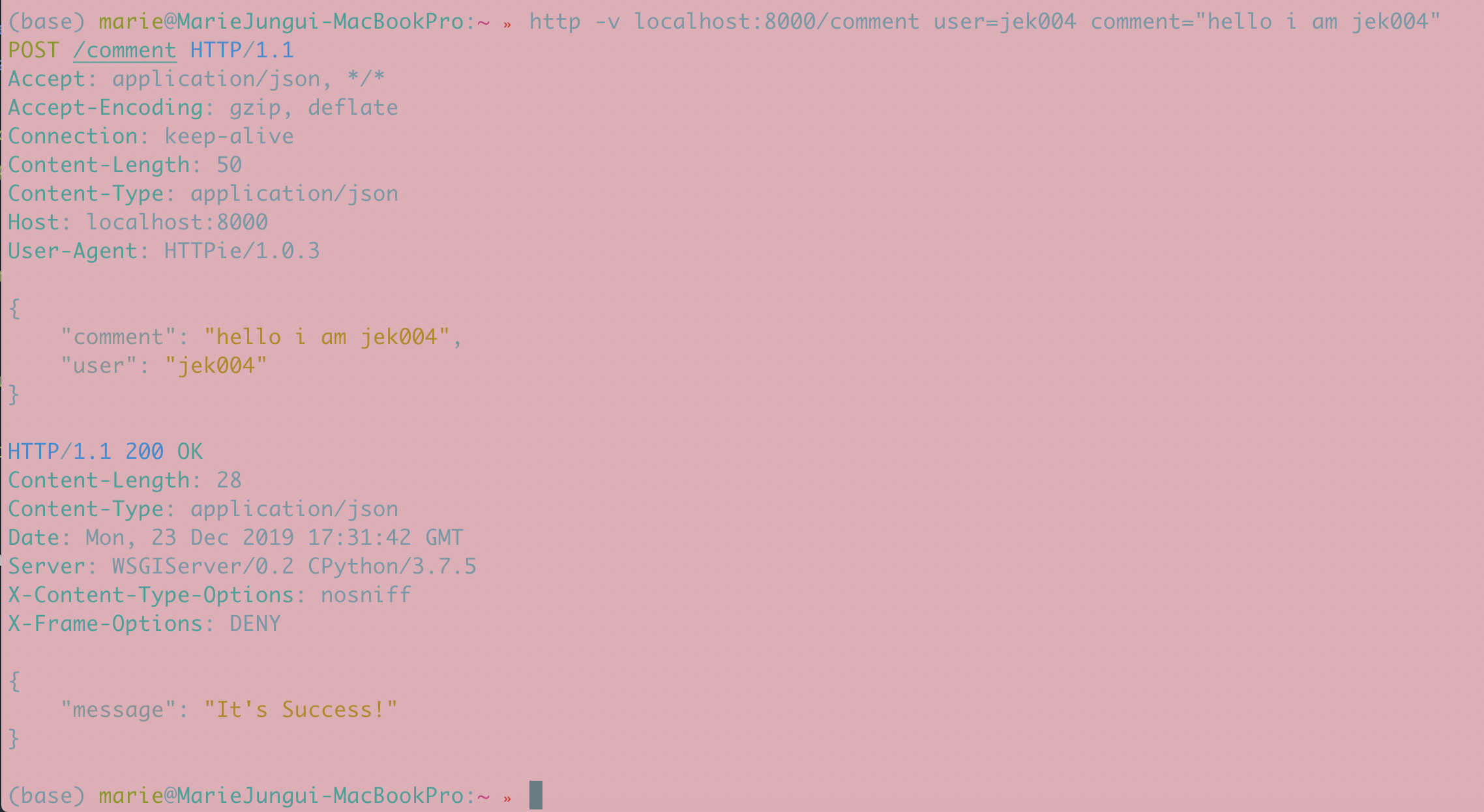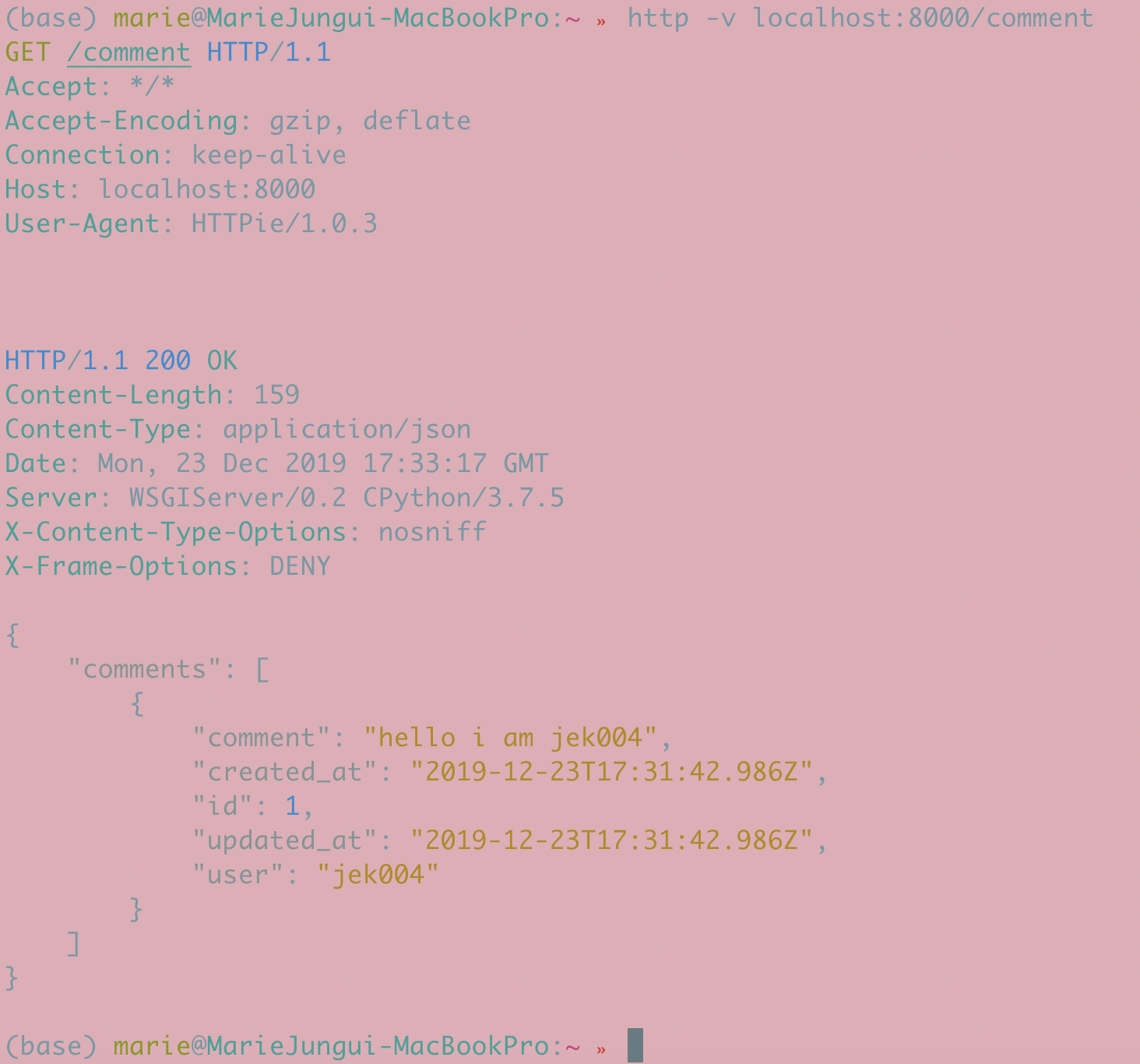1) "comment"라는 이름의 APP 생성
(test_project) marie@MarieJungui-MacBookPro:~/mynewdjango »
(test_project) marie@MarieJungui-MacBookPro:~/mynewdjango » pwd
/Users/marie/mynewdjango
(test_project) marie@MarieJungui-MacBookPro:~/mynewdjango » tree
.
├── db.sqlite3
├── manage.py
├── mynewjangodirec
│ ├── __init__.py
│ ├── __pycache__
│ │ ├── __init__.cpython-37.pyc
│ │ ├── settings.cpython-37.pyc
│ │ ├── urls.cpython-37.pyc
│ │ └── wsgi.cpython-37.pyc
│ ├── asgi.py
│ ├── settings.py
│ ├── urls.py
│ └── wsgi.py
└── user
├── __init__.py
├── __pycache__
│ ├── __init__.cpython-37.pyc
│ ├── admin.cpython-37.pyc
│ ├── models.cpython-37.pyc
│ ├── urls.cpython-37.pyc
│ └── views.cpython-37.pyc
├── admin.py
├── apps.py
├── migrations
│ ├── 0001_initial.py
│ ├── __init__.py
│ └── __pycache__
│ ├── 0001_initial.cpython-37.pyc
│ └── __init__.cpython-37.pyc
├── models.py
├── tests.py
├── urls.py
└── views.py
6 directories, 27 files
(test_project) marie@MarieJungui-MacBookPro:~/mynewdjango »
(test_project) marie@MarieJungui-MacBookPro:~/mynewdjango » python manage.py startapp comment
(test_project) marie@MarieJungui-MacBookPro:~/mynewdjango »
(test_project) marie@MarieJungui-MacBookPro:~/mynewdjango » pwd
/Users/marie/mynewdjango
(test_project) marie@MarieJungui-MacBookPro:~/mynewdjango » tree
.
├── comment
│ ├── __init__.py
│ ├── admin.py
│ ├── apps.py
│ ├── migrations
│ │ └── __init__.py
│ ├── models.py
│ ├── tests.py
│ └── views.py
├── db.sqlite3
├── manage.py
├── mynewjangodirec
│ ├── __init__.py
│ ├── __pycache__
│ │ ├── __init__.cpython-37.pyc
│ │ ├── settings.cpython-37.pyc
│ │ ├── urls.cpython-37.pyc
│ │ └── wsgi.cpython-37.pyc
│ ├── asgi.py
│ ├── settings.py
│ ├── urls.py
│ └── wsgi.py
└── user
├── __init__.py
├── __pycache__
│ ├── __init__.cpython-37.pyc
│ ├── admin.cpython-37.pyc
│ ├── models.cpython-37.pyc
│ ├── urls.cpython-37.pyc
│ └── views.cpython-37.pyc
├── admin.py
├── apps.py
├── migrations
│ ├── 0001_initial.py
│ ├── __init__.py
│ └── __pycache__
│ ├── 0001_initial.cpython-37.pyc
│ └── __init__.cpython-37.pyc
├── models.py
├── tests.py
├── urls.py
└── views.py
8 directories, 34 files
(test_project) marie@MarieJungui-MacBookPro:~/mynewdjango »2) 댓글을 저장할 db 생성: 댓글 DB 클래스 생성(models.py)
(test_project) marie@MarieJungui-MacBookPro:~/mynewdjango »
(test_project) marie@MarieJungui-MacBookPro:~/mynewdjango » pwd
/Users/marie/mynewdjango
(test_project) marie@MarieJungui-MacBookPro:~/mynewdjango » tree
.
├── comment
│ ├── __init__.py
│ ├── admin.py
│ ├── apps.py
│ ├── migrations
│ │ └── __init__.py
│ ├── models.py
│ ├── tests.py
│ └── views.py
├── db.sqlite3
├── manage.py
├── mynewjangodirec
│ ├── __init__.py
│ ├── __pycache__
│ │ ├── __init__.cpython-37.pyc
│ │ ├── settings.cpython-37.pyc
│ │ ├── urls.cpython-37.pyc
│ │ └── wsgi.cpython-37.pyc
│ ├── asgi.py
│ ├── settings.py
│ ├── urls.py
│ └── wsgi.py
└── user
├── __init__.py
├── __pycache__
│ ├── __init__.cpython-37.pyc
│ ├── admin.cpython-37.pyc
│ ├── models.cpython-37.pyc
│ ├── urls.cpython-37.pyc
│ └── views.cpython-37.pyc
├── admin.py
├── apps.py
├── migrations
from django.db import models
│ ├── 0001_initial.py
│ ├── __init__.py
│ └── __pycache__
│ ├── 0001_initial.cpython-37.pyc
│ └── __init__.cpython-37.pyc
├── models.py
├── tests.py
├── urls.py
└── views.py
8 directories, 34 files
(test_project) marie@MarieJungui-MacBookPro:~/mynewdjango »
(test_project) marie@MarieJungui-MacBookPro:~/mynewdjango » cat ./comment/models.py
from django.db import models
# Create your models here.
(test_project) marie@MarieJungui-MacBookPro:~/mynewdjango »
(test_project) marie@MarieJungui-MacBookPro:~/mynewdjango » vi ./comment/models.py
(test_project) marie@MarieJungui-MacBookPro:~/mynewdjango » cat ./comment/models.py
from django.db import models
# Create your models here.
class Comments(models.Model):
user = models.CharField(max_length = 50)
comment = models.CharField(max_length = 500)
created_at = models.DateTimeField(auto_now_add = True)
updated_at = models.DateTimeField(auto_now = True)
class Meta:
db_table = 'comments'
(test_project) marie@MarieJungui-MacBookPro:~/mynewdjango »3) 생성한 "comment" 앱을 settings.py에 추가하기
(test_project) marie@MarieJungui-MacBookPro:~/mynewdjango » 2 ↵
(test_project) marie@MarieJungui-MacBookPro:~/mynewdjango » cat ./mynewjangodirec/settings.py 2 ↵
"""
Django settings for mynewjangodirec project.
Generated by 'django-admin startproject' using Django 3.0.1.
For more information on this file, see
https://docs.djangoproject.com/en/3.0/topics/settings/
For the full list of settings and their values, see
https://docs.djangoproject.com/en/3.0/ref/settings/
"""
import os
# Build paths inside the project like this: os.path.join(BASE_DIR, ...)
BASE_DIR = os.path.dirname(os.path.dirname(os.path.abspath(__file__)))
# Quick-start development settings - unsuitable for production
# See https://docs.djangoproject.com/en/3.0/howto/deployment/checklist/
# SECURITY WARNING: keep the secret key used in production secret!
SECRET_KEY = 'u8(7%^1zs80hb(93lyxg_+s=+a12b465m^*lk4e$8bar4v&oll'
# SECURITY WARNING: don't run with debug turned on in production!
DEBUG = True
ALLOWED_HOSTS = ['*']
# Application definition
INSTALLED_APPS = [
# 'django.contrib.admin',
# 'django.contrib.auth',
'django.contrib.contenttypes',
'django.contrib.sessions',
'django.contrib.messages',
'django.contrib.staticfiles',
'user',
]
MIDDLEWARE = [
'django.middleware.security.SecurityMiddleware',
'django.contrib.sessions.middleware.SessionMiddleware',
'django.middleware.common.CommonMiddleware',
#'django.middleware.csrf.CsrfViewMiddleware',
#'django.contrib.auth.middleware.AuthenticationMiddleware',
'django.contrib.messages.middleware.MessageMiddleware',
'django.middleware.clickjacking.XFrameOptionsMiddleware',
]
ROOT_URLCONF = 'mynewjangodirec.urls'
TEMPLATES = [
{
'BACKEND': 'django.template.backends.django.DjangoTemplates',
'DIRS': [],
'APP_DIRS': True,
'OPTIONS': {
'context_processors': [
'django.template.context_processors.debug',
'django.template.context_processors.request',
'django.contrib.auth.context_processors.auth',
'django.contrib.messages.context_processors.messages',
],
},
},
]
WSGI_APPLICATION = 'mynewjangodirec.wsgi.application'
# Database
# https://docs.djangoproject.com/en/3.0/ref/settings/#databases
DATABASES = {
'default': {
'ENGINE': 'django.db.backends.sqlite3',
'NAME': os.path.join(BASE_DIR, 'db.sqlite3'),
}
}
# Password validation
# https://docs.djangoproject.com/en/3.0/ref/settings/#auth-password-validators
AUTH_PASSWORD_VALIDATORS = [
{
'NAME': 'django.contrib.auth.password_validation.UserAttributeSimilarityValidator',
},
{
'NAME': 'django.contrib.auth.password_validation.MinimumLengthValidator',
},
{
'NAME': 'django.contrib.auth.password_validation.CommonPasswordValidator',
},
{
'NAME': 'django.contrib.auth.password_validation.NumericPasswordValidator',
},
]
# Internationalization
# https://docs.djangoproject.com/en/3.0/topics/i18n/
LANGUAGE_CODE = 'en-us'
TIME_ZONE = 'UTC'
USE_I18N = True
USE_L10N = True
USE_TZ = True
# Static files (CSS, JavaScript, Images)
# https://docs.djangoproject.com/en/3.0/howto/static-files/
STATIC_URL = '/static/'
##Disable_slash
APPEND_SLASH = False
(test_project) marie@MarieJungui-MacBookPro:~/mynewdjango »
(test_project) marie@MarieJungui-MacBookPro:~/mynewdjango » vi ./mynewjangodirec/settings.py
(test_project) marie@MarieJungui-MacBookPro:~/mynewdjango »
(test_project) marie@MarieJungui-MacBookPro:~/mynewdjango » cat ./mynewjangodirec/settings.py
"""
Django settings for mynewjangodirec project.
Generated by 'django-admin startproject' using Django 3.0.1.
For more information on this file, see
https://docs.djangoproject.com/en/3.0/topics/settings/
For the full list of settings and their values, see
https://docs.djangoproject.com/en/3.0/ref/settings/
"""
import os
# Build paths inside the project like this: os.path.join(BASE_DIR, ...)
BASE_DIR = os.path.dirname(os.path.dirname(os.path.abspath(__file__)))
# Quick-start development settings - unsuitable for production
# See https://docs.djangoproject.com/en/3.0/howto/deployment/checklist/
# SECURITY WARNING: keep the secret key used in production secret!
SECRET_KEY = 'u8(7%^1zs80hb(93lyxg_+s=+a12b465m^*lk4e$8bar4v&oll'
# SECURITY WARNING: don't run with debug turned on in production!
DEBUG = True
ALLOWED_HOSTS = ['*']
# Application definition
INSTALLED_APPS = [
# 'django.contrib.admin',
# 'django.contrib.auth',
'django.contrib.contenttypes',
'django.contrib.sessions',
'django.contrib.messages',
'django.contrib.staticfiles',
'user',
'comment',
]
MIDDLEWARE = [
'django.middleware.security.SecurityMiddleware',
'django.contrib.sessions.middleware.SessionMiddleware',
'django.middleware.common.CommonMiddleware',
#'django.middleware.csrf.CsrfViewMiddleware',
#'django.contrib.auth.middleware.AuthenticationMiddleware',
'django.contrib.messages.middleware.MessageMiddleware',
'django.middleware.clickjacking.XFrameOptionsMiddleware',
]
ROOT_URLCONF = 'mynewjangodirec.urls'
TEMPLATES = [
{
'BACKEND': 'django.template.backends.django.DjangoTemplates',
'DIRS': [],
'APP_DIRS': True,
'OPTIONS': {
'context_processors': [
'django.template.context_processors.debug',
'django.template.context_processors.request',
'django.contrib.auth.context_processors.auth',
'django.contrib.messages.context_processors.messages',
],
},
},
]
WSGI_APPLICATION = 'mynewjangodirec.wsgi.application'
# Database
# https://docs.djangoproject.com/en/3.0/ref/settings/#databases
DATABASES = {
'default': {
'ENGINE': 'django.db.backends.sqlite3',
'NAME': os.path.join(BASE_DIR, 'db.sqlite3'),
}
}
# Password validation
# https://docs.djangoproject.com/en/3.0/ref/settings/#auth-password-validators
AUTH_PASSWORD_VALIDATORS = [
{
'NAME': 'django.contrib.auth.password_validation.UserAttributeSimilarityValidator',
},
{
'NAME': 'django.contrib.auth.password_validation.MinimumLengthValidator',
},
{
'NAME': 'django.contrib.auth.password_validation.CommonPasswordValidator',
},
{
'NAME': 'django.contrib.auth.password_validation.NumericPasswordValidator',
},
]
# Internationalization
# https://docs.djangoproject.com/en/3.0/topics/i18n/
LANGUAGE_CODE = 'en-us'
TIME_ZONE = 'UTC'
USE_I18N = True
USE_L10N = True
USE_TZ = True
# Static files (CSS, JavaScript, Images)
# https://docs.djangoproject.com/en/3.0/howto/static-files/
STATIC_URL = '/static/'
##Disable_slash
APPEND_SLASH = False
(test_project) marie@MarieJungui-MacBookPro:~/mynewdjango »4) comment 앱 migrate 하기
(test_project) marie@MarieJungui-MacBookPro:~/mynewdjango »
(test_project) marie@MarieJungui-MacBookPro:~/mynewdjango » python manage.py makemigrations comment
Migrations for 'comment':
comment/migrations/0001_initial.py
- Create model Comments
(test_project) marie@MarieJungui-MacBookPro:~/mynewdjango »
(test_project) marie@MarieJungui-MacBookPro:~/mynewdjango » pwd
/Users/marie/mynewdjango
(test_project) marie@MarieJungui-MacBookPro:~/mynewdjango » tree
.
├── comment
│ ├── __init__.py
│ ├── __pycache__
│ │ ├── __init__.cpython-37.pyc
│ │ └── models.cpython-37.pyc
│ ├── admin.py
│ ├── apps.py
│ ├── migrations
│ │ ├── 0001_initial.py
│ │ ├── __init__.py
│ │ └── __pycache__
│ │ └── __init__.cpython-37.pyc
│ ├── models.py
│ ├── tests.py
│ └── views.py
├── db.sqlite3
├── manage.py
├── mynewjangodirec
│ ├── __init__.py
│ ├── __pycache__
│ │ ├── __init__.cpython-37.pyc
│ │ ├── settings.cpython-37.pyc
│ │ ├── urls.cpython-37.pyc
│ │ └── wsgi.cpython-37.pyc
│ ├── asgi.py
│ ├── settings.py
│ ├── urls.py
│ └── wsgi.py
└── user
├── __init__.py
├── __pycache__
│ ├── __init__.cpython-37.pyc
│ ├── admin.cpython-37.pyc
│ ├── models.cpython-37.pyc
│ ├── urls.cpython-37.pyc
│ └── views.cpython-37.pyc
├── admin.py
├── apps.py
├── migrations
│ ├── 0001_initial.py
│ ├── __init__.py
│ └── __pycache__
│ ├── 0001_initial.cpython-37.pyc
│ └── __init__.cpython-37.pyc
├── models.py
├── tests.py
├── urls.py
└── views.py
10 directories, 38 files
(test_project) marie@MarieJungui-MacBookPro:~/mynewdjango »
(test_project) marie@MarieJungui-MacBookPro:~/mynewdjango » python manage.py migrate comment 0001
Operations to perform:
Target specific migration: 0001_initial, from comment
Running migrations:
Applying comment.0001_initial... OK
(test_project) marie@MarieJungui-MacBookPro:~/mynewdjango »
(test_project) marie@MarieJungui-MacBookPro:~/mynewdjango » tree
.
├── comment
│ ├── __init__.py
│ ├── __pycache__
│ │ ├── __init__.cpython-37.pyc
│ │ └── models.cpython-37.pyc
│ ├── admin.py
│ ├── apps.py
│ ├── migrations
│ │ ├── 0001_initial.py
│ │ ├── __init__.py
│ │ └── __pycache__
│ │ ├── 0001_initial.cpython-37.pyc
│ │ └── __init__.cpython-37.pyc
│ ├── models.py
│ ├── tests.py
│ └── views.py
├── db.sqlite3
├── manage.py
├── mynewjangodirec
│ ├── __init__.py
│ ├── __pycache__
│ │ ├── __init__.cpython-37.pyc
│ │ ├── settings.cpython-37.pyc
│ │ ├── urls.cpython-37.pyc
│ │ └── wsgi.cpython-37.pyc
│ ├── asgi.py
│ ├── settings.py
│ ├── urls.py
│ └── wsgi.py
└── user
├── __init__.py
├── __pycache__
│ ├── __init__.cpython-37.pyc
│ ├── admin.cpython-37.pyc
│ ├── models.cpython-37.pyc
│ ├── urls.cpython-37.pyc
│ └── views.cpython-37.pyc
├── admin.py
├── apps.py
├── migrations
│ ├── 0001_initial.py
│ ├── __init__.py
│ └── __pycache__
│ ├── 0001_initial.cpython-37.pyc
│ └── __init__.cpython-37.pyc
├── models.py
├── tests.py
├── urls.py
└── views.py
10 directories, 39 files
(test_project) marie@MarieJungui-MacBookPro:~/mynewdjango »5) comment 앱의 views.py 입력하기
(test_project) marie@MarieJungui-MacBookPro:~/mynewdjango »
(test_project) marie@MarieJungui-MacBookPro:~/mynewdjango » pwd
/Users/marie/mynewdjango
(test_project) marie@MarieJungui-MacBookPro:~/mynewdjango »
(test_project) marie@MarieJungui-MacBookPro:~/mynewdjango » tree
.
├── comment
│ ├── __init__.py
│ ├── __pycache__
│ │ ├── __init__.cpython-37.pyc
│ │ └── models.cpython-37.pyc
│ ├── admin.py
│ ├── apps.py
│ ├── migrations
│ │ ├── 0001_initial.py
│ │ ├── __init__.py
│ │ └── __pycache__
│ │ ├── 0001_initial.cpython-37.pyc
│ │ └── __init__.cpython-37.pyc
│ ├── models.py
│ ├── tests.py
│ └── views.py
├── db.sqlite3
├── manage.py
├── mynewjangodirec
from django.shortcuts import render
│ ├── __init__.py
│ ├── __pycache__
│ │ ├── __init__.cpython-37.pyc
│ │ ├── settings.cpython-37.pyc
│ │ ├── urls.cpython-37.pyc
│ │ └── wsgi.cpython-37.pyc
│ ├── asgi.py
│ ├── settings.py
│ ├── urls.py
│ └── wsgi.py
└── user
├── __init__.py
├── __pycache__
│ ├── __init__.cpython-37.pyc
│ ├── admin.cpython-37.pyc
│ ├── models.cpython-37.pyc
│ ├── urls.cpython-37.pyc
│ └── views.cpython-37.pyc
├── admin.py
├── apps.py
├── migrations
│ ├── 0001_initial.py
│ ├── __init__.py
│ └── __pycache__
│ ├── 0001_initial.cpython-37.pyc
│ └── __init__.cpython-37.pyc
├── models.py
├── tests.py
├── urls.py
└── views.py
10 directories, 39 files
(test_project) marie@MarieJungui-MacBookPro:~/mynewdjango »
(test_project) marie@MarieJungui-MacBookPro:~/mynewdjango » cat ./comment/views.py
from django.shortcuts import render
# Create your views here.
(test_project) marie@MarieJungui-MacBookPro:~/mynewdjango »
(test_project) marie@MarieJungui-MacBookPro:~/mynewdjango » vi ./comment/views.py
(test_project) marie@MarieJungui-MacBookPro:~/mynewdjango »
(test_project) marie@MarieJungui-MacBookPro:~/mynewdjango » cat ./comment/views.py
from django.shortcuts import render
# Create your views here.
import json
from django.views import View
from django.http import JsonResponse
from .models import Comments
class CommentView(View):
def post(self, request):
data = json.loads(request.body)
print(data)
Comments(
user = data['user'],
comment = data['comment'],
).save()
return JsonResponse({'message':'It\'s Success!'}, status=200)
def get(self, request):
data = list(Comments.objects.values())
print(data)
return JsonResponse({'comments':data}, status=200)
(test_project) marie@MarieJungui-MacBookPro:~/mynewdjango »6) comment 앱의 urls.py 만들기
(test_project) marie@MarieJungui-MacBookPro:~/mynewdjango »
(test_project) marie@MarieJungui-MacBookPro:~/mynewdjango » tree
.
├── comment
│ ├── __init__.py
│ ├── __pycache__
│ │ ├── __init__.cpython-37.pyc
│ │ └── models.cpython-37.pyc
│ ├── admin.py
│ ├── apps.py
│ ├── migrations
│ │ ├── 0001_initial.py
│ │ ├── __init__.py
│ │ └── __pycache__
│ │ ├── 0001_initial.cpython-37.pyc
│ │ └── __init__.cpython-37.pyc
│ ├── models.py
│ ├── tests.py
│ └── views.py
├── db.sqlite3
├── manage.py
├── mynewjangodirec
│ ├── __init__.py
│ ├── __pycache__
│ │ ├── __init__.cpython-37.pyc
│ │ ├── settings.cpython-37.pyc
│ │ ├── urls.cpython-37.pyc
│ │ └── wsgi.cpython-37.pyc
│ ├── asgi.py
│ ├── settings.py
│ ├── urls.py
│ └── wsgi.py
└── user
├── __init__.py
├── __pycache__
│ ├── __init__.cpython-37.pyc
│ ├── admin.cpython-37.pyc
│ ├── models.cpython-37.pyc
│ ├── urls.cpython-37.pyc
│ └── views.cpython-37.pyc
├── admin.py
├── apps.py
├── migrations
│ ├── 0001_initial.py
│ ├── __init__.py
│ └── __pycache__
│ ├── 0001_initial.cpython-37.pyc
│ └── __init__.cpython-37.pyc
├── models.py
├── tests.py
├── urls.py
└── views.py
10 directories, 39 files
(test_project) marie@MarieJungui-MacBookPro:~/mynewdjango »
(test_project) marie@MarieJungui-MacBookPro:~/mynewdjango » pwd
/Users/marie/mynewdjango
(test_project) marie@MarieJungui-MacBookPro:~/mynewdjango »
(test_project) marie@MarieJungui-MacBookPro:~/mynewdjango » cp ./user/urls.py ./comment/.
(test_project) marie@MarieJungui-MacBookPro:~/mynewdjango »
(test_project) marie@MarieJungui-MacBookPro:~/mynewdjango » tree
.
├── comment
│ ├── __init__.py
│ ├── __pycache__
│ │ ├── __init__.cpython-37.pyc
│ │ └── models.cpython-37.pyc
│ ├── admin.py
│ ├── apps.py
│ ├── migrations
│ │ ├── 0001_initial.py
│ │ ├── __init__.py
│ │ └── __pycache__
│ │ ├── 0001_initial.cpython-37.pyc
│ │ └── __init__.cpython-37.pyc
│ ├── models.py
│ ├── tests.py
│ ├── urls.py
│ └── views.py
├── db.sqlite3
├── manage.py
├── mynewjangodirec
│ ├── __init__.py
│ ├── __pycache__
│ │ ├── __init__.cpython-37.pyc
│ │ ├── settings.cpython-37.pyc
│ │ ├── urls.cpython-37.pyc
│ │ └── wsgi.cpython-37.pyc
│ ├── asgi.py
│ ├── settings.py
│ ├── urls.py
│ └── wsgi.py
└── user
├── __init__.py
├── __pycache__
│ ├── __init__.cpython-37.pyc
│ ├── admin.cpython-37.pyc
│ ├── models.cpython-37.pyc
│ ├── urls.cpython-37.pyc
│ └── views.cpython-37.pyc
├── admin.py
├── apps.py
├── migrations
│ ├── 0001_initial.py
"""mynewjangodirec URL Configuration
│ ├── __init__.py
│ └── __pycache__
│ ├── 0001_initial.cpython-37.pyc
│ └── __init__.cpython-37.pyc
├── models.py
├── tests.py
├── urls.py
└── views.py
10 directories, 40 files
(test_project) marie@MarieJungui-MacBookPro:~/mynewdjango »
(test_project) marie@MarieJungui-MacBookPro:~/mynewdjango »
(test_project) marie@MarieJungui-MacBookPro:~/mynewdjango » cat ./comment/urls.py
"""mynewjangodirec URL Configuration
The `urlpatterns` list routes URLs to views. For more information please see:
https://docs.djangoproject.com/en/3.0/topics/http/urls/
Examples:
Function views
1. Add an import: from my_app import views
2. Add a URL to urlpatterns: path('', views.home, name='home')
Class-based views
1. Add an import: from other_app.views import Home
2. Add a URL to urlpatterns: path('', Home.as_view(), name='home')
Including another URLconf
1. Import the include() function: from django.urls import include, path
2. Add a URL to urlpatterns: path('blog/', include('blog.urls'))
"""
from django.urls import path
from .views import UserView, AuthView #이 파일(urls.py)이 위치한 디렉터리의 views.py파일에서 클래스 UserViewdhk 클래스 AuthView를 import!
urlpatterns = [
path('', UserView.as_view()), #".as_view()"는 진입메소드로! http 메소드(get,post)를 알아내는 dispatch() 메소드를 호출한다
path('/auth', AuthView.as_view()),
]
(test_project) marie@MarieJungui-MacBookPro:~/mynewdjango »
(test_project) marie@MarieJungui-MacBookPro:~/mynewdjango » vi ./comment/urls.py
(test_project) marie@MarieJungui-MacBookPro:~/mynewdjango »
(test_project) marie@MarieJungui-MacBookPro:~/mynewdjango » cat ./comment/urls.py
"""mynewjangodirec URL Configuration
The `urlpatterns` list routes URLs to views. For more information please see:
https://docs.djangoproject.com/en/3.0/topics/http/urls/
Examples:
Function views
1. Add an import: from my_app import views
2. Add a URL to urlpatterns: path('', views.home, name='home')
Class-based views
1. Add an import: from other_app.views import Home
2. Add a URL to urlpatterns: path('', Home.as_view(), name='home')
Including another URLconf
1. Import the include() function: from django.urls import include, path
2. Add a URL to urlpatterns: path('blog/', include('blog.urls'))
"""
from django.urls import path
from .views import CommentView #이 파일(urls.py)이 위치한 디렉터리의 views.py파일에서 클래스인 CommentView를 import!
urlpatterns = [
path('', CommentView.as_view()), #".as_view()"는 진입메소드로! http 메소드(get,post)를 알아내는 dispatch() 메소드를 호출한다
]
(test_project) marie@MarieJungui-MacBookPro:~/mynewdjango »7) 장고프로젝트의 urls.py에다가 comment앱의 경로 추가하기
(test_project) marie@MarieJungui-MacBookPro:~/mynewdjango » pwd
/Users/marie/mynewdjango
(test_project) marie@MarieJungui-MacBookPro:~/mynewdjango » tree
.
├── comment
│ ├── __init__.py
│ ├── __pycache__
│ │ ├── __init__.cpython-37.pyc
│ │ └── models.cpython-37.pyc
│ ├── admin.py
│ ├── apps.py
│ ├── migrations
│ │ ├── 0001_initial.py
│ │ ├── __init__.py
│ │ └── __pycache__
│ │ ├── 0001_initial.cpython-37.pyc
│ │ └── __init__.cpython-37.pyc
│ ├── models.py
│ ├── tests.py
│ ├── urls.py
│ └── views.py
├── db.sqlite3
├── manage.py
├── mynewjangodirec
│ ├── __init__.py
│ ├── __pycache__
│ │ ├── __init__.cpython-37.pyc
│ │ ├── settings.cpython-37.pyc
│ │ ├── urls.cpython-37.pyc
│ │ └── wsgi.cpython-37.pyc
│ ├── asgi.py
│ ├── settings.py
│ ├── urls.py
│ └── wsgi.py
└── user
├── __init__.py
├── __pycache__
│ ├── __init__.cpython-37.pyc
│ ├── admin.cpython-37.pyc
│ ├── models.cpython-37.pyc
│ ├── urls.cpython-37.pyc
│ └── views.cpython-37.pyc
├── admin.py
├── apps.py
"""mynewjangodirec URL Configuration
├── migrations
│ ├── 0001_initial.py
│ ├── __init__.py
│ └── __pycache__
│ ├── 0001_initial.cpython-37.pyc
│ └── __init__.cpython-37.pyc
├── models.py
├── tests.py
├── urls.py
└── views.py
10 directories, 40 files
(test_project) marie@MarieJungui-MacBookPro:~/mynewdjango »
(test_project) marie@MarieJungui-MacBookPro:~/mynewdjango » cat ./mynewjangodirec/urls.py
"""mynewjangodirec URL Configuration
The `urlpatterns` list routes URLs to views. For more information please see:
https://docs.djangoproject.com/en/3.0/topics/http/urls/
Examples:
Function views
1. Add an import: from my_app import views
2. Add a URL to urlpatterns: path('', views.home, name='home')
Class-based views
1. Add an import: from other_app.views import Home
2. Add a URL to urlpatterns: path('', Home.as_view(), name='home')
Including another URLconf
1. Import the include() function: from django.urls import include, path
2. Add a URL to urlpatterns: path('blog/', include('blog.urls'))
"""
#from django.contrib import admin
from django.urls import path, include
urlpatterns = [
# path('admin/', admin.site.urls),
path('user',include('user.urls') ), # "user"라는 url은 user파일 하단의 "urls"파일로 토스!
]
(test_project) marie@MarieJungui-MacBookPro:~/mynewdjango »
(test_project) marie@MarieJungui-MacBookPro:~/mynewdjango » vi ./mynewjangodirec/urls.py
(test_project) marie@MarieJungui-MacBookPro:~/mynewdjango »
(test_project) marie@MarieJungui-MacBookPro:~/mynewdjango » cat ./mynewjangodirec/urls.py
"""mynewjangodirec URL Configuration
The `urlpatterns` list routes URLs to views. For more information please see:
https://docs.djangoproject.com/en/3.0/topics/http/urls/
Examples:
Function views
1. Add an import: from my_app import views
2. Add a URL to urlpatterns: path('', views.home, name='home')
Class-based views
1. Add an import: from other_app.views import Home
2. Add a URL to urlpatterns: path('', Home.as_view(), name='home')
Including another URLconf
1. Import the include() function: from django.urls import include, path
2. Add a URL to urlpatterns: path('blog/', include('blog.urls'))
"""
#from django.contrib import admin
from django.urls import path, include
urlpatterns = [
# path('admin/', admin.site.urls),
path('user',include('user.urls') ), # "user"라는 url은 user파일 하단의 "urls"파일로 토스!
path('comment', include('comment.urls')),
]
(test_project) marie@MarieJungui-MacBookPro:~/mynewdjango »8) 가상 서버에서 comment 앱 실행해보기
8-1) 장고서버 실행

8-2) comment 입력하기


8-3) comment 확인하기


